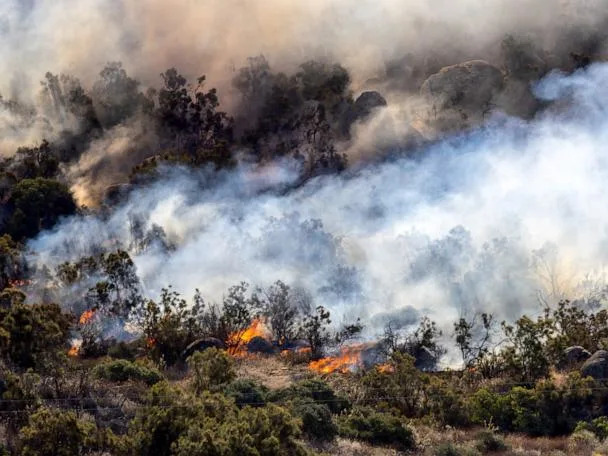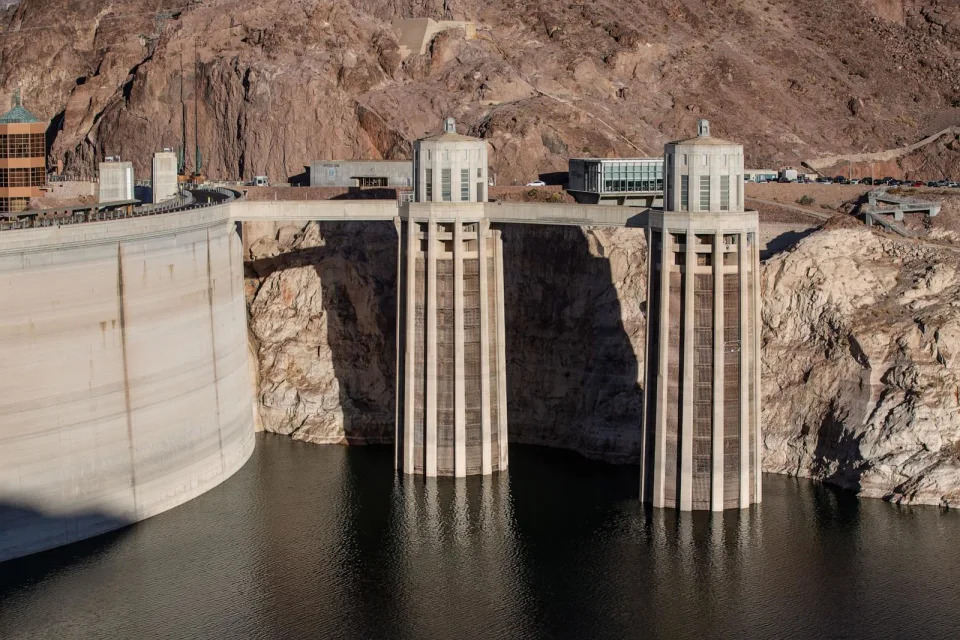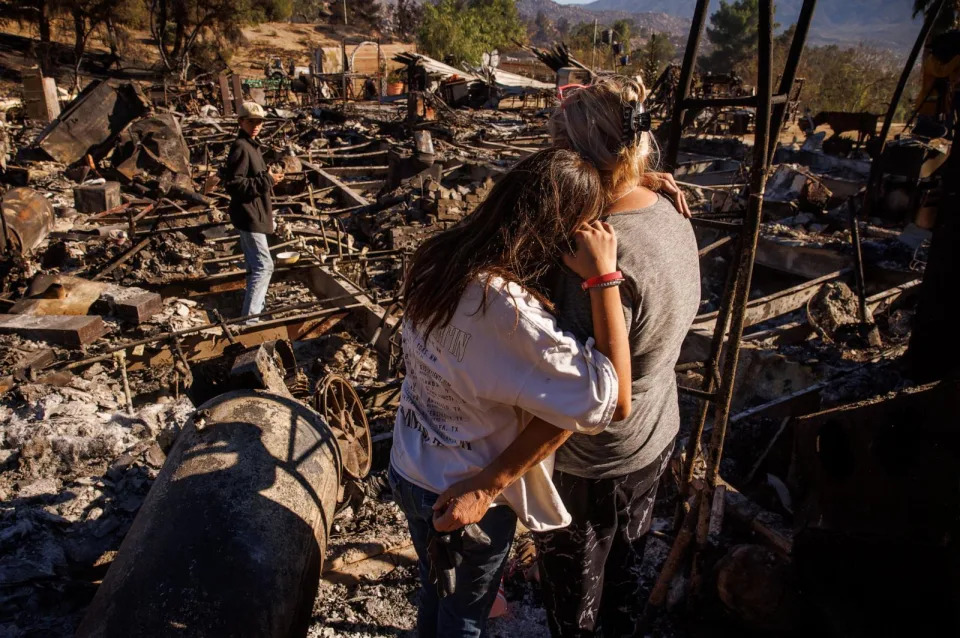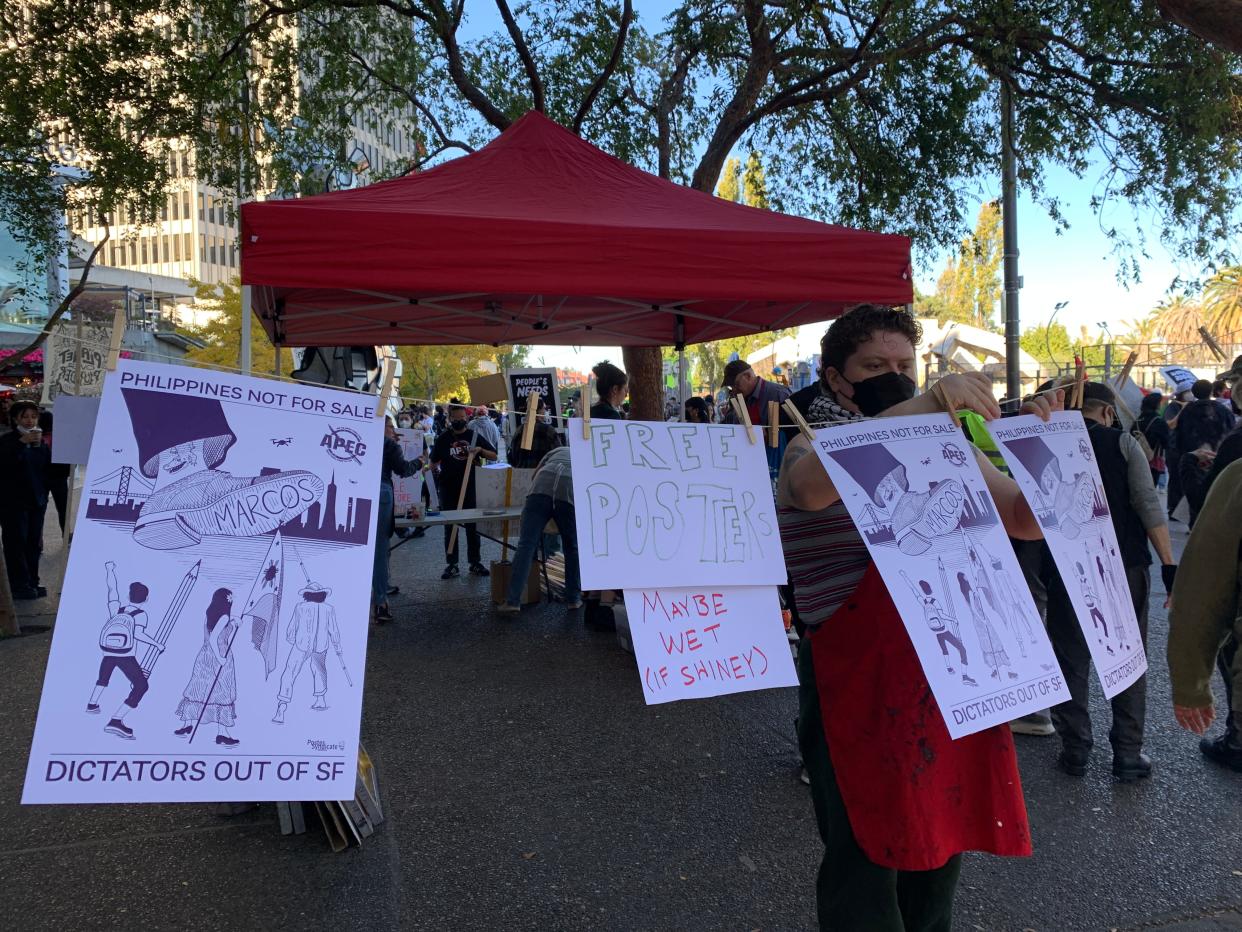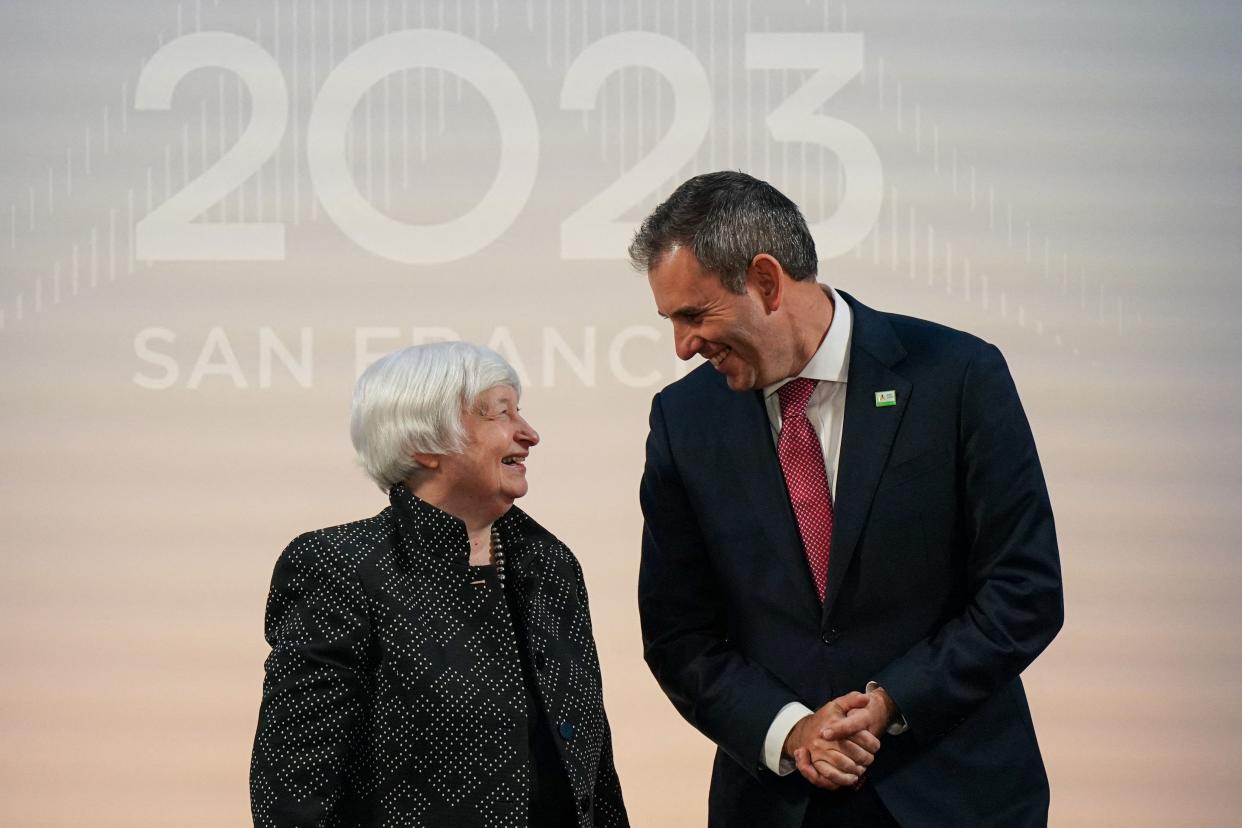Corporate growers' carrots are soaking up water. Locals are fighting back with a boycott
Ian James
Mon, November 13, 2023

Carrots are grown in the Cuyama Valley, where residents have banded together in a boycott targeting large growers over water concerns. (Luis Sinco / Los Angeles Times)
In the Cuyama Valley north of Santa Barbara, lush green fields stretch across the desert. Sprinklers spray thousands of acres to grow a single thirsty crop: carrots.
Wells and pumps pull groundwater from as deep as 680 feet, and the aquifer’s levels are dropping.
As the valley’s only water source shrinks, a bitter legal battle over water rights has arisen between carrot growers and the community. Residents are fighting back with a campaign urging everyone to stop buying carrots.
Along the valley’s roads, in cattle pastures and outside homes and businesses, signs and banners have sprung up declaring “BOYCOTT CARROTS” and “STAND WITH CUYAMA AGAINST CORPORATE GREED.”

An old truck props up a sign promoting a boycott against two companies that farm carrots in the Cuyama Valley. (Luis Sinco / Los Angeles Times)
The signs target two of the world’s largest carrot-growing companies, Grimmway Farms and Bolthouse Farms, which are the valley’s biggest water users.
The companies stirred outrage when they, along with several other allied entities, sued property owners throughout the valley, asking a court to determine how much water everyone can pump.
The lawsuit, filed in 2021, has left small farmers, ranchers and other property owners with staggering legal bills. Residents have accused the companies of going to court to try to secure as much water as possible, while forcing painful cuts on smaller farms.
“They're all for themselves. It's all about the money,” said Chris Wegis, who runs a family farm with her husband. “It's totally disheartening that somebody wants to come in and basically destroy you for their own personal gain.”
After many residents rallied around the carrot boycott, Bolthouse Farms and Grimmway Farms recently dropped out of the lawsuit, filing requests to remove themselves as plaintiffs. Other companies that lease farmland to the growers are staying on as plaintiffs and pressing ahead with the case.

A mechanical harvester collects carrots from a field near the town of New Cuyama. (Luis Sinco / Los Angeles Times)
Grimmway Farms, the largest carrot grower in the world, said in an email to The Times that the lawsuit was intended to “ensure an equitable allocation of water basin-wide to protect the groundwater rights of all users.”
“It has become clear, however, that many do not support the adjudication,” the company said. "Our relationships with the residents of Cuyama are more important and valuable to us than this court case."
Both Grimmway and Bolthouse said they are committed to reducing water use and taking part in the valley's groundwater management plan, which the state recently approved.
But residents and small farmers said they remain at odds with the carrot growers and will continue the boycott.
Records show the two carrot companies pumped more than 28,000 acre-feet of water last year, accounting for about 65% of all measured pumping reported to the local groundwater agency. Together, the companies used nearly three times the annual water use of the city of Santa Barbara.

Jim Wegis, left, and his wife, Chris, farm olives in the Cuyama Valley. The longtime residents are concerned about a legal fight over groundwater rights in the area. (Luis Sinco / Los Angeles Times)
Wegis and her husband, Jim, have been running their family farm since 1979 near lands where his ancestors homesteaded and ranched in the 1800s.
Five years ago, the Wegises stopped growing alfalfa, an especially water-intensive crop, and planted about 200 acres of olive trees, which require much less water. Chris Wegis said while they have made substantial investments to reduce water use, they have watched the carrot farms expand and drill more wells.
“They have come in and basically — excuse my language — raped our valley,” Wegis said. “They are the problem. They are the ones that are not sustainable."
Read more: Thousands of California wells are at risk of drying up despite landmark water law
Wegis spoke while picking olives to sample their oil content. She said the carrot growers’ tactics put local farms like hers in danger. Their family business is already in debt, and they are fighting to survive, she said.
“Our blood, sweat and tears are in this land,” Wegis said. “And for someone to come in and try to rob us of our livelihood and take it from us, for their own profit, it's unrighteous. I mean, it's just criminal.”
The conflict in the Cuyama Valley is one of several that have emerged in parts of California where farming communities are grappling with chronic groundwater depletion. Landowners have filed suit in four other similar cases, including in Ventura County and Ridgecrest, seeking court adjudications to determine how much groundwater they should be able to pump.
The cases often take years to reach a judgment.
The lawsuits are complicating California’s efforts to implement pumping limits and other requirements of the state’s landmark 2014 groundwater law, the Sustainable Groundwater Management Act.
In many areas of California and the Southwest, the depletion of groundwater has been worsening, outpacing efforts to impose regulation and threatening future water availability at a time when climate change is straining supplies. As aquifers are drained by excessive pumping, water reserves that seeped underground over thousands of years are being used up.
In one recent study, researchers found that California’s current plans for addressing overpumping aren’t nearly stringent enough, leaving thousands of wells at risk of running dry.
The Cuyama Valley is one of 21 groundwater basins that state officials have deemed “critically overdrafted.” The law requires local agencies in these areas to develop plans to halt overpumping and stabilize groundwater levels by 2040.
In the Cuyama Valley, achieving those goals is expected to require slashing water use by as much as two-thirds.

Charlie Bosma feeds cattle at his ranch in the Cuyama Valley. Bosma helped organize the boycott of carrots after carrot-growing companies sued other property owners asking a court to determine groundwater pumping rights. (Luis Sinco / Los Angeles Times)
A group of residents launched the carrot boycott at a meeting in July, saying they are fed up with the companies’ lawsuit and excessive pumping. Organizers designed signs and bumper stickers, and began handing them out.
“The only way to get their attention is through boycotting their products so that they realize the pain that they're causing,” said Charlie Bosma, one of the organizers. He said the goal is to send a message that the community won't let the carrot companies “just destroy this valley.”
Bosma grew up in the Cuyama Valley and lives on a cattle ranch, where he uses his well to irrigate fruit trees and grapevines. He works as the high school’s athletic director and coaches the football team.
Bosma's legal bills have topped $11,000.

A sign promoting the carrot boycott hangs on a fence at Charlie Bosma's ranch in the Cuyama Valley. (Luis Sinco / Los Angeles Times)
The local drinking water supplier in New Cuyama, the Cuyama Community Services District, is proposing to cover its legal costs by adding a $20-a-month surcharge to bills — a costly burden for many low-income residents.
Bosma said it’s especially galling that the school district has had to spend $15,000 so far to defend its interests.
“That's taking money out of what we could put into our kids,” Bosma said. “It's gouging our school. It's gouging our water district. It's gouging every landowner in this valley.”
The group began circulating an online petition calling for Grimmway and Bolthouse to halt their overpumping, end the lawsuit and reimburse residents for their legal fees.
Bosma said carrot cake happens to be his favorite dessert, but he has started eating zucchini cake instead.
“For our valley, this is the most important battle that we hopefully will ever face — because of how damaging it could be if we don't get it right,” he said.
Read more: California's epic rain year boosted groundwater levels, but not enough to recoup losses
In recent years, representatives of the Bakersfield-based carrot companies participated as the local groundwater agency developed its plan for reducing pumping.
Grimmway Farms said it’s not in favor of cutting the water rights of the local water district, the high school or small residential water users.
Bolthouse Farms said in an emailed statement that the company's decision to withdraw from the lawsuit was “driven by our commitment to sustainability.”
“We at Bolthouse Farms recognize the issue of groundwater depletion and take the matter very seriously,” the company said. “We are actively reducing water usage by 5% for two years and have committed to doing so by approximately 60% by 2040.”

Sprinklers irrigate a carrot field in the Cuyama Valley in October. (Luis Sinco / Los Angeles Times)
One of the remaining plaintiffs is Bolthouse Land Co., a subsidiary of Bolthouse Properties, which split from Bolthouse Farms in 2005 and leases land to the farming company.
Daniel Clifford, vice president and general counsel for Bolthouse Properties, said the litigation will “allow for a collaborative process involving all parties, in conjunction with court oversight” and is intended to help the Cuyama Basin meet the objectives of the state’s groundwater law by establishing legally enforceable water allocations.
Read more: She was killed in a carrot field. With her body nearby, workers say, they were told to keep picking
“The only way the Cuyama Basin will achieve sustainability is if water cutbacks are shared equally among all groundwater users,” Clifford said in an email. “The fact that some significant groundwater users were unwilling to agree to a reduction in their groundwater usage necessitated the assistance of the Court.”
The legal fight has been complicated by disputes among agricultural landowners over how the cuts should be apportioned.
Some growers, including Jim and Chris Wegis, have argued the carrot growers created the problem and should deal with it. The Wegises have said water levels are relatively stable in their area, and they point to studies showing a fault separates the aquifer from the central portion of the basin where declines are occurring beneath the carrot farms.
Clifford blamed those who are trying to challenge the basin’s boundaries for “driving up the legal fees,” and said the solution must be a “basin-wide” approach with everyone shouldering equal cutbacks.
Bosma said the decisions by Grimmway and Bolthouse Farms to pull out of the lawsuit are a step in the right direction, but not nearly enough.
He said the boycott will continue “until they want to actually come to the table and fix it.”
The Cuyama River has been flowing after this year’s rains in parts of the valley. But large stretches of the riverbed usually sit parched beside the farmlands.
Water in the Cuyama Valley’s aquifer accumulated underground over millenniums. A large portion of that ancient water reserve has been depleted by decades of heavy pumping.
Older residents remember seeing wetlands where water once flowed from the aquifer and nourished cottonwood trees. But as water was pumped to irrigate alfalfa and other crops in the 1960s and '70s, some wetlands dried up and cottonwoods died as water levels declined.
Some of the first carrot growers arrived in the 1980s, buying alfalfa fields.
Read more: 'Full-on crisis': Groundwater in California's Central Valley disappearing at alarming rate
Over the past two decades, the carrot-growing operations have shifted from family-run companies to corporate giants, and have expanded to larger acreages.
As the boycott has grown, those who have joined the effort include farmers who grow pistachios, grapes and other crops.
Tristan Zannon, who manages his family’s pistachio farm, said he and many others were surprised when the companies decided on the “nuclear option” of suing.

Tristan Zannon stands beside a well at his family's organic pistachio farm in the Cuyama Valley. (Luis Sinco / Los Angeles Times)
“I think some accountant decided that it was cheaper to fight through litigation,” Zannon said with a laugh.
As Zannon walked through his orchard, workers harvested pistachios with machinery, shaking the trees and sending nuts raining down.
Zannon said he has begun looking at areas where trees can be ripped out to reduce water use.
Meanwhile, declining water levels in wells near the carrot farms are bringing higher pumping costs, as well as worsening water quality with higher salinity, Zannon said. “We're scared to death that we won't have water in 10, 15 years.”
Zannon said it’s wrong that the carrot growers who have caused much of the overdraft problem are positioning themselves to get the largest water allocations.
The adjudication case has opened up a parallel path for fighting over water separate from state-mandated regulation, Zannon said, and the fact that several lawsuits have popped up in just a few years indicates California will probably see more such cases in the courts as scarcity continues to fan conflicts.

Jean Gaillard has a small farm in the Cuyama Valley. (Luis Sinco / Los Angeles Times)
“It's a good time to be a water lawyer,” Zannon said. “This is the beginning of the water wars.”
Nearby, Jean Gaillard and Meg Brown run a small farm where they grow a variety of vegetables, including squash, cucumbers, spinach and onions. They pump a minimal amount of water to supply the farm, but the water level in their well has been dropping about a foot and a half per year.
Gaillard knelt at the edge of his field, where a white crust covered the ground. He took a pinch in his fingers and brought it to his tongue.
“There’s salt in there, and that’s never good for farming,” Gaillard said. “That has been worsening over the years.”

Sprinklers spray a carrot field in the Cuyama Valley. (Luis Sinco / Los Angeles Times)
Standing beside his home, Gaillard looked out over the vast carrot fields.
“They're hurting a lot of people by extracting all the water,” he said. “They are unsustainable.”
'We're not going to quit': Why a California community is boycotting carrots
Mon, November 13, 2023
Many people who live among the cattle ranches and farms in the Cuyama Valley have banded together in a campaign calling for a boycott of carrots.
The effort targets two large carrot growers, Grimmway Farms and Bolthouse Farms, which sued asking a court to determine groundwater allocations for property owners throughout the valley. The two companies have recently dropped out of the lawsuit, but other corporate entities that lease land to the growers remain in the water adjudication case as plaintiffs.
Residents in the rural community north of Santa Barbara say they plan to continue protesting the companies’ tactics by boycotting carrots. Here's what several people in the Cuyama Valley have to say about the current fight over water and their community’s future.
Jake Furstenfeld, a cattle rancher and boycott organizer

Jake Furstenfeld, a rancher, helped organize a protest campaign in the Cuyama Valley urging people to boycott carrots. (Luis Sinco / Los Angeles Times)
"I’ve never seen our community more united on something"
Jake Furstenfeld has for years served on an advisory committee to the Cuyama Basin Groundwater Sustainability Agency, discussing plans to reduce pumping alongside representatives of the carrot companies. In that process, he said, he felt everyone had a voice. But he’s now concerned the carrot growers, which have been overpumping water for years, might end up controlling a large share of the remaining water, to the community’s detriment.
“I’ve never seen our community more united on something,” Furstenfeld said. “I feel we have to get our word out in order for this valley to survive.”
Furstenfeld said he sees the boycott as an effort to defend the community’s water future for the next generation, including his 9-year-old daughter.
“We’ve got to fight,” he said. “We’re not going to quit.”
Steve Gliessman and Roberta Jaffe, owners of a 5-acre vineyard

Steve Gliessman and Roberta Jaffe run Condor's Hope Vineyard in the Cuyama Valley. (Luis Sinco / Los Angeles Times)
Steve Gliessman and Roberta Jaffe own Condor’s Hope Vineyard at the foot of the Sierra Madre Mountains, where they dry-farm wine grapes without irrigation, relying on the rains.
They have been involved in other debates over water, opposing a large vineyard company’s proposal to build three water storage reservoirs. That project, which Jaffe and Gliessman warned would drain an excessive amount of groundwater, was rejected in a vote last month by Santa Barbara County supervisors.
Jaffe said the community has come together to support the carrot boycott because “it's very much the small guys up against the very deep pockets.”
Gliessman, a retired agroecology professor at UC Santa Cruz, said the lawsuit led residents who were previously supportive of the carrot companies to see them in a new light.
“We said these guys aren't here for us. They're here for profit, and that's all,” Gliessman said. “Boy, did that ignite a level of anger and anxiety amongst the community that led them to put together the boycott.”
Rosalba Fonseca, community advocate

Rosalba Fonseca is a community advocate who works with farmworkers in the Cuyama Valley. (Luis Sinco / Los Angeles Times)
Rosalba Fonseca has lived here for much of her life and works as a community advocate helping farmworkers. She said while she supports the carrot boycott, the conflict over water has created divisions and she hopes the matter can be resolved.
“Since I've been here, everybody looks out for each other. So having this dilemma is heartbreaking,” Fonseca said.
She said many low-income families already struggle to pay their water bills, and they’re now facing a plan to raise rates, which includes a $20-a-month surcharge to offset the local utility's legal costs from the lawsuit.
“They're concerned about the prices. They're concerned about not having water in the future,” Fonseca said. But many laborers are also worried, she said, that speaking out might jeopardize their jobs.
"We need the companies," Fonseca said. "But we also have to make sure that they hear the voice of the community, and understand that the water is essential for us, to not take it away."
Pam Doiron, rancher

Pam Doiron raises cattle at the Spanish Ranch in the Cuyama Valley. (Luis Sinco / Los Angeles Times)
"We live sustainability and we live stewardship.”
Pam Doiron lives in the western part of the valley on a cattle ranch called the Spanish Ranch, which was once part of a Mexican land grant dating to 1843. She and her family use minimal water on the ranch, where cattle graze in pastures beside the Cuyama River.
“We’ve tried to be cautious with our water use,” Doiron said. “We live sustainability and we live stewardship.”
The carrot companies have taken a different approach, she said, by expanding their operations, drilling more wells and pumping heavily.
Doiron said she worries about neighbors hit with legal bills they can’t afford, and about the court case’s potential to harm property values. She said carrots require too much water, and planting them on such a large scale is irresponsible.
“It's the wrong crop at the wrong place,” she said. “We all know, by living in this valley and taking care of it, that you can't do a major industrial farming operation and pump like they do — and sustain the lifestyle.”
Brenton Kelly, watershed advocate and community facilitator

Brenton Kelly is the director of watershed advocacy at Quail Springs Permaculture in the Cuyama Valley, where he and other residents pipe water from a spring to their farm. (Luis Sinco / Los Angeles Times)
Brenton Kelly helps run a small farm that is radically different from the carrot-growing operations. He lives and works at Quail Springs Permaculture, a nonprofit and off-grid community where he and others grow vegetables and nourish their goats and chickens using water piped from a natural spring.
The water, which emerges from the foothills of Mt. Pinos, is filtered in two tubs, and then piped with gravity to tanks that supply the farm. Kelly has worked for years to help the spring ecosystem recover after decades of intensive cattle grazing.
Kelly said he supports the carrot boycott because “we’re very much against corporate greed.”
“Ultimately, we have to find a way to say that the groundwater is not the corporates' privatized profit and property right. It just can't be,” Kelly said. “We have to learn to share these things.”
Kelly also chairs the advisory committee to the Cuyama Basin groundwater agency. He is concerned that with the slow implementation of pumping limits under the local groundwater plan, the area isn’t on track to addressing the overpumping problem, and in the meantime, large growers will continue to deplete the aquifer.
“They’re buying time,” Kelly said. “The sooner we turn down the pumps, the more will be left.”
Bonnie Goller, retired scientist and longtime resident

Bonnie Goller is a longtime resident of the Cuyama Valley who is taking part in the community's boycott of carrots. (Luis Sinco / Los Angeles Times)
“I feel like our groundwater is under siege.”
Bonnie Goller has lived in the Cuyama Valley for 40 years. She has seen wetlands dry up in parts of the valley as groundwater levels have declined over the years. A creek still flows on her ranch, where she relies on a well for her home and occasionally for her olive trees.
Goller has a “BOYCOTT CARROTS” banner on her front gate. She said she fears the lawsuit could allow large growers to secure more water while placing limits on other landowners.
“I feel like our groundwater is under siege,” Goller said.
She said she worries that because she and her family use very little water, an eventual ruling in the case could prevent her adult sons from drilling a well to grow crops, limiting how the land could be used.
Goller and other residents were incensed when they saw the companies’ legal teams, seeking to notify all landowners, had delivered copies of the lawsuit in envelopes attached to dozens of wooden stakes, which they hammered into the ground along roads.
Goller collected more than two dozen envelopes that were posted on stakes by her gate and along nearby roads. She put the stack of envelopes in a box and mailed them back to the law office.
“This is vandalism!” she told the lawyers in a handwritten note. “Shame on you!”
Carrot companies respond

Sprinklers spray a carrot field in the Cuyama Valley. (Luis Sinco / Los Angeles Times)
Since the start of the carrot boycott in July, Grimmway Farms and Bolthouse Farms have both filed requests to withdraw from the lawsuit as plaintiffs. Other companies that lease land to the growers, among them Bolthouse Properties, remain in the case.
Grimmway Farms said in an email that its intention in filing the water adjudication lawsuit “was to ensure an equitable allocation of water basin-wide to protect the groundwater rights of all users.”
“It has become clear, however, that many do not support the adjudication,” the company said, “and the goodwill and cooperation that has defined our farming and relationships in the Cuyama Valley for so many years is significantly compromised.”
Grimmway Farms, which leases about 13,000 acres in the valley, said now that it is no longer a plaintiff, “we feel it more appropriate for the landowners to continue this discussion.”
Bolthouse Farms said in an email that the company had reevaluated its involvement in the case and “believe that, given our existing actions to reduce water, it no longer makes sense to continue as a plaintiff.”
Residents who are leading the carrot boycott say they plan to continue their campaign. In addition to seeking an end to the lawsuit, they have demanded the companies stop overpumping groundwater and reimburse residents for their legal fees.
This story originally appeared in Los Angeles Times.





